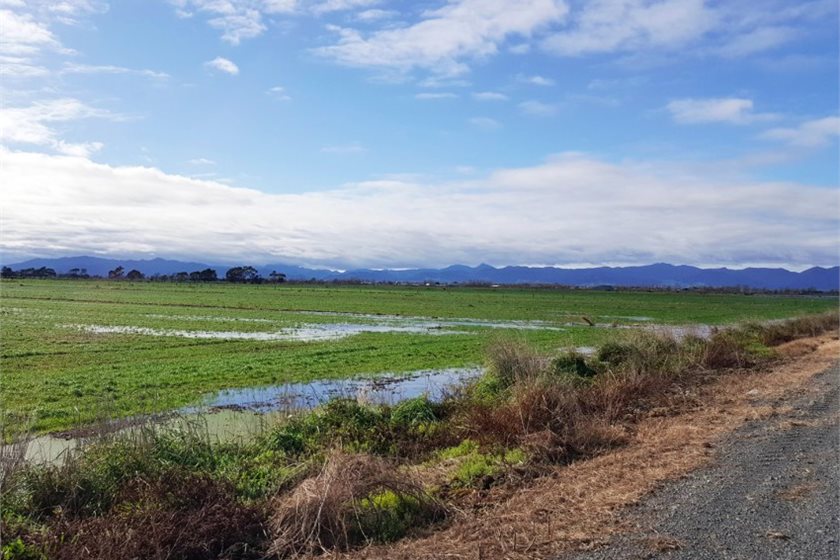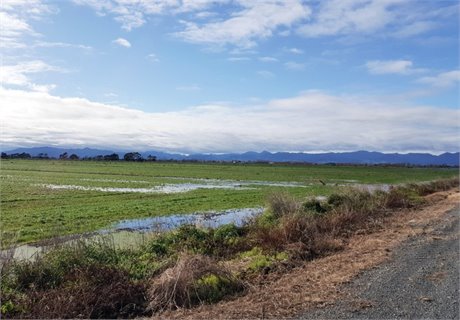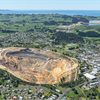Proposal to include non-forestry land in NDC calculation
25 Oct 2023

 |
| Peat soils close to sea level after rainfall in Hauraki. Photo Manaaki Whenua |
By Jeremy Rose
A Cabinet minute from July of this year agreed in principle to include non-forest land in New Zealand’s nationally determined contribution.
Including the roughly 60% of New Zealand land currently not covered by the country’s NDC would initially increase New Zealand’s emissions by an estimated 0.2 - 1.3 MtCO2e per year, according to the Nationally Determined Contribution Strategy Cabinet paper, proactively released by the Ministry for the Environment last week.
However, the paper’s author, outgoing climate change minister James Shaw, said including non-forestry land in the NDC would encourage investment into non-forest land use and management initiatives which could both reduce emissions and offer significant co-benefits, such as flood risk reduction and enhancing biodiversity.
To meet our nationally determined contribution (NDC) under the Paris Agreement, New Zealand has promised to abate an estimated 99 MtCO2e over and above achieving the first two domestic emissions budgets
The Cabinet paper gives the example of reducing emissions from drained peatlands, which currently contribute 4 to 5 MtCO2e per year, as one of the benefits of including non-forest lands in the NDC.
It says including non-forest lands - such as grassland, cropland and wetland - in NDC accounting is a necessary step to respond to calls from the agricultural sector for other types of carbon removal to be included in the country’s emissions reduction accounting.
The 4 to 5 MtCO2e estimate of carbon emissions from drained peatlands comes from work carried out by Waikato University associate professor of environmental science, David Campbell, and colleagues for the Ministry of Primary Industries and Ministry for the Environment.
Campbell says they’ve also looked at ways to reduce those emissions. “That’s the really tricky bit because really the only sure-fire way to reduce emissions from drained peat soils is to re-wet them.
“That could be anything from raising the water-table so you can still use them as productive land for grazing or some sort of food or fibre production but under a higher water table regime which is probably not very suitable for the current primary use of grazing by dairy cattle,” he says.
The other option is a full restoration of wetlands and taking them out of agricultural production altogether.
“Those are really the only mitigations that have been shown in the international literature and practice in places like Europe to be truly effective to reduce or eliminate those emissions.”
 |
| IMAGE: UK Centre for Ecology & Hydrology |
Campbell says the obvious place to start is in areas where there are drained peak soils that are currently too wet to be used for their traditional land use either because of changes in hydrology or abandonment of pump drainage schemes.
He says Muggeridge Basin in Hauraki, which has effectively been abandoned because it’s too expensive to drain, is an example of somewhere that should be returned to a full wetland.
Low hanging fruit
Drained peat soils cover about 170,000 hectares or 1% of the country’s soil area. “That 1% emits something like 8 to 10% of New Zealand’s net emissions. By anyone’s definition that’s low hanging fruit.”
Campbell says the Cabinet paper shows just how many uncertainties still exist when it comes to buying overseas carbon credits to offset our emissions.
Treasury and Ministry for the Environment have estimated (or guesstimated) it will cost between $3 billion and $24 billion to buy offshore carbon credits just to meet New Zealand's NDC to 2030.
And Campbell points out there’s not even a market that’s been agreed to under the Paris Convention.
“But just throwing some numbers at it if you imagine it costs $80 a tonne to offset four megatonnes equivalent of CO2 emissions offshore, that's $320 million and five megatonnes is $400 million.
“And I’m guessing you’ll have to double those numbers by the time credits become available because there will be a lot of countries competing for them.”
He says there’s no question that that 1% of soil has the potential to significantly reduce or even mitigate the country’s emission but the work hasn’t been done in New Zealand.
Paludiculture

Wet agriculture, or paludiculture, is being advocated by some, but Campbell says it’s never been tested in New Zealand.
In Europe, reeds for thatching are grown on wetlands but there’s little demand for thatch in New Zealand.
“But if high-value crops can be found, it might allow farmers to rewet or restore larger areas. NZ-specific crops might be harakeke or raupo, if suitable markets could be found. But it will always be a niche opportunity and it's not something I advocate for.”
He says New Zealand is far from alone in looking for ways to reduce emissions from peat soils. “Denmark has committed to or has a goal of abandoning a hundred thousand hectares of peak soils presently under agriculture by 2030 and it has got a five billion kroner [NZ$1.24 billion] budget to do that.”
Allowing forestry on peat soils would be a mistake
Campbell says the suggestion that farmers should be able to claim carbon credits for trees grown on small plots of land would be counter-productive when it comes to peat soils.
That’s because trees grown on drained peat soils would sequester less carbon than the soils are releasing. “We’re talking about 20 tons of carbon dioxide equivalent per hectare per year.”
A CO2 mountain to climb
The Cabinet paper says there’s an an estimated 99 MtCO2-e of additional abatement needed to meet the NDC over and above achievement of our first two domestic emissions budgets.
And it warns there’s a risk of overshooting the first emissions budget, the budget for 2022 - 2025, meaning the second emissions budget, for 2026 - 2030, will need deliver greater emission reductions.
The paper says non-forest abatement should be encouraged in climate policy in advance of its eventual inclusion to New Zealand’s NDC by 2030.
A consultation on developing a draft strategy for including non-forest land and carbon capture in New Zealand’s emission accounting is planned for next year.
print this story
Story copyright © Carbon News 2023










